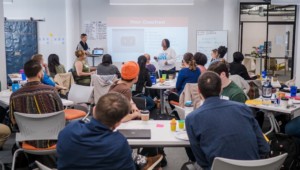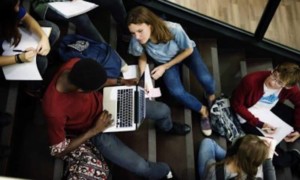SEL in the Era of COVID-19

By: Lori Jackson
The Learning Counsel’s 2019 Survey of School and District Digital Curriculum Strategy and Transformation identified, for the first time ever, social-emotional needs as outranking every other major issue facing K-12 schools. In fact, this topic has become so important in the education conversation that I recently had the chance to speak about it on the debut episode of Education Today, a new podcast from Soundtrap for Education.
Clearly, educators are feeling the pain. When I speak with teachers, families, and communities across the nation, they see mental health issues in children that have never been seen before. Equally concerning is that they don’t have plans and aren’t always prepared to appropriately handle them.
According to the Pew Research Center, anxiety and depression among young people are on the rise. More than four-in-ten say bullying, drug addiction, and alcohol consumption are major problems affecting people their age, according to a recent Pew Research Center survey of U.S. teenagers.
On top of it all, the COVID-19 pandemic has temporarily forced districts to shut down schools, exacerbating students’ anxiety, confusion, and fears about their future. And certainly, teachers are not immune to the same stressors. We must act now.
What a Proactive SEL Approach Looks Like Right Now
Many times, parents and teachers do their best to shield school-aged kids from difficult conversations surrounding global issues. However, kids are already discussing coronavirus with each other or seeing comments on Instagram and Snapchat. For younger children, this could result in feeling emotions they can’t yet express. Their behavior could start to change. So it’s important to recognize the signs early and take a proactive approach.
It’s crucial to start by creating a safe and open environment to encourage children to share how they feel. Keep in mind, it’s important to acknowledge and accept whatever emotions they are showing and feeling.
Next, we must do more to support schools in helping them empower children to address their social-emotional needs. The good news is that social-emotional learning (SEL) is not an amorphous topic.
SEL is effective in increasing academic outcomes and supporting students’ overall emotional well-being. Studies show many students with disabilities and social issues struggle with regulating emotions. If students can’t regulate emotions, they can’t learn.
Therefore, directly targeting the development of emotional regulation in students is not only useful in SEL but necessary for true behavioral change and developing skills that can be generalized across settings and situations.
SEL boils down to teaching foundational and fundamental skills that children need in order to empower themselves to drive their own learning. Just as teaching academic skills helps students think through and solve problems, teaching social-emotional skills helps students to identify the source of their emotions and offer solutions to help manage those emotions.
Along the way, new neural pathways in the brain can be created. The more we repeat a certain behavior, the stronger the corresponding pathway in the brain becomes.
Attacking the Anxiety of Teaching SEL
But teaching social-emotional learning is not easy. When I visit classrooms and meet with teachers, I see anxiety. They worry, “Am I teaching this right?” Add the element of distance learning and disrupting children’s daily routines in the era of COVID-19, and teachers could easily feel overwhelmed.
The first thing we can do is just reassure teachers. We need to tell them, “You do this every minute of every day. You are simply teaching. You are just fine.”
Teachers are not mental health counselors. They are just great teachers. This realization will help them see that SEL is manageable.
Our KidConnect Ready2Learn app, for example, teaches students the critical skills to manage themselves. The curriculum scope and sequence teaches the foundational SEL skills that students need. The program integrates ideas with established classroom routines so students apply SEL skills in real time, using real life situations. And the app goes hand-in-hand with what digital natives know. This is the best way to stop talking at them, and instead, allowing them to drive their own learning.
Be Specific When Giving an Example
It’s important that adults connect the feelings they’re experiencing to specific events. By doing so, we:
- Give emotions context.
- Help children realize it’s normal to have feelings associated with new or unusual events in their lives.
- Give them a window into what other people are feeling.
Teaching SEL in the World of COVID-19
This is our new normal.
“This” means distance learning, distance teaching, distance meetings, everyone at a distance.
Even at a distance, “this” is the perfect time to get serious about teaching SEL. This means teaching everyone to identify, understand, and manage their emotions so they can be in charge of their own learning and behavior. We can do this from a distance, and here’s how.
1. It’s all about emotions.
This is the place to begin for parents, kids, teachers, administrators, and all school staff. Being able to manage emotions right now in a period of uncertainty is critical to keep learning and working moving smoothly.
The first step in this process is to be able to identify your emotions. Teachers can model different emotions in online sessions by first modeling how they feel and then asking kids to do the same. This can become a routine. How is everyone feeling today? The critical piece is to ask why. When we give emotions context, we help connect them to the events and issues that are driving them, which aids learning and stores the information for later use.
2. Make a plan to manage emotions.
It’s not enough just to acknowledge we all have emotions right now; planning what to do when they are felt is even more important than ever.
For teachers this can be done during their distance learning sessions, emails to students and parents. It starts with modeling.
“This morning I was feeling a little anxious when I woke up so I went outside and did 10 jumping jacks on my porch. This helped me to feel a little less anxious so I could make a plan for the day.”
This kind of modeling from parents and teachers will help kids to learn they are in control of their response to the emotions. During distance learning sessions, teachers can ask kids to offer ideas and suggestions for strategies to manage different emotions and then ask kids to practice and share how it went the next time they “meet.”
3. Build empathy for others. We are all in this together.
This is a good time to build a team. We can’t be together or play together but we can understand and share our common emotions, strategies, and ideas of how to manage this difficult time. Learning from each other right now is key to making distance learning less remote and less isolating.
4. It all takes time.
We aren’t expecting mastery of academic subjects right now, so patience in this area is needed, too. Just make a plan to make emotions a focus every day. You’ll be surprised at how enthusiastic your students and kids are to discuss them.
Our new “normal” doesn’t mean we have to give up on SEL until we are back to school. In fact, it’s the best time to try a new approach.
For more, see:
- Social Emotional Learning and the Future of Education
- Extending Social Emotional Learning Into the Home
- How To Get Students Talking About Their Own Social-Emotional Learning
Stay in-the-know with innovations in learning by signing up for the weekly Smart Update.
Getting Smart has launched the Getting Through series to support educators, leaders, and families on the path forward during such an uncertain time. This series will provide resources and inspiration as we face long term school closures, new learning environments, and address equity and access from a new lens. Whether you are just getting started with distance or online learning, or you’ve had plans in place and have the opportunity to share your work and guidance with others, there is a place for your voice and an opportunity to learn.







Carol Dlesk
Good reminder on how to stick together.
Carol Dlesk
There are a lot of things to cover in a classroom and SEL is a key component to any well run classroom.
Karen Scott
I really never consider the social emotional aspect of distant learning. I think the challenge is how to incorporate it into everyday lessons. I believe that maybe I will try and send out a mass email to each class asking how each student is feeling that day and then determine based on response how to proceed. I am thinking next step might be a discussion board. Maybe as simple as what do you do each day. How do you fit learning into your day.
Sue Carlson
I believe all the ideas in both the videos shown and the thoughts expressed in the articles have value. They connect with how people are feeling and how to deal with those emotions. It is important that we acknowledge and respect different feelings and find a way to make and keep that connection. And learning through others is a great first step.
My biggest concern after experiencing this new endeavor is the setting, both for the teacher and the student. People need to feel like they are in a physical space that mirrors the objective, in this case learning and teaching. I needed to establish a comfort zone in a physical way. (I did not accomplish that yet) I think the ideas of setting a routine. remembering that this is still a place of business and accepting it may be the way of the future are essential for success.
Karen Caballero
This article opened my eyes to the fact that not only are the kids' emotions are being challenged, but also the parents. The more positive I can be in my Zoom meetings and expressing reassurance, the better the whole family will be. Parents are listening to what we teachers have to say and we can be that calming voice that settles the anxiety the family feels. The article makes me want to be an even bigger cheerleader in voicing we got this and we'll make it through. I always say I can do anything if I know it's temporary and I feel this virus is just that. It may be a long temporary, but it will be cured and we must stay vigilant and build our stamina.
Joseph Savage
So many teachers that I have worked with address social emotional issues naturally. It is healthy for adults to acknowledge/share some of their own feelings and responses to difficulties (within reason), this is modeling behavior that can be useful to and healthy for students.
christine Schenider
The article pointed out everyone is struggling emotionally with the situation we are in. That includes staff, the students, and their parents who try to keep their students engaged. I think it was important that mentioned to acknowledge these feelings and talk about a plan on how to manage them, even having the teacher model the feelings they are having and how to deal with them.
Michelle Hill
This was a good article as a reminder to continue to make connections with our students. It does not matter if you are in a classroom or online. Teachers just need to be who they are!
Amber Ambrose
The hardest thing that everyone is dealing with are emotions because as humans we are not made to be unsocial. As educators we need to make sure we are addressing the needs of ourselves as well as our students mental feelings. We need to be available to how they are feeling and help them express ways to cope with this new way of life.
Jenny Schaefer
Great info and reminders
Margaret Cleveland
Very good reminders
karen Galloway
I does make a difference to make those connections with everything that is going on right now.
Kathy Stempinski
Making a connection on the emotional level of a student is key to having a good relationship with that student. If the student feels you care and understand their anxiety and fears they are more apt to open up about their feelings.
Kathy Stempinski
I feel that a student will open up to an adult if they feel the adult gets them. Making a student feel comfortable can lead to open dialogue regarding all their fears and anxieties.
Christine Duncan
Very good article.
Christine Duncan
Checking in with the student is very important, especially now. I usually start by asking the student how they are feeling today. Many times the student will tell you how they are doing or you can read the body language of the student. Having that connection is important.